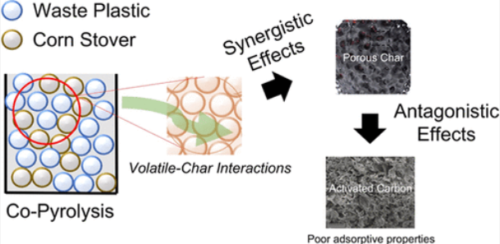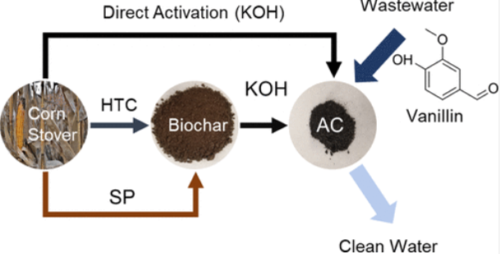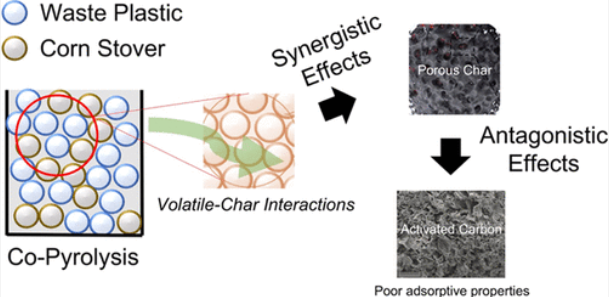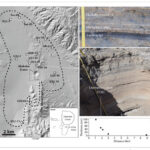- プラスチックとトウモロコシの廃棄物から有用な炭を作るUCRの方法
UCR method creates useful char from plastic and corn waste
- プラスチックとコーンストーバーの共加熱分解によるチャーおよび活性炭の生成と相乗効果および拮抗効果。 Synergistic and Antagonistic Effects of the Co-Pyrolysis of Plastics and Corn Stover to Produce Char and Activated Carbon
- バイオマス残渣からのバイオ炭および活性炭の物理化学的性質: プロセス条件の吸着剤特性への影響 Physiochemical Properties of Biochar and Activated Carbon from Biomass Residue: Influence of Process Conditions to Adsorbent Properties
プラスチックとトウモロコシの廃棄物から有用な炭を作るUCRの方法 UCR method creates useful char from plastic and corn waste
2023-01-05 カリフォルニア大学リバーサイド校(UCR)
このような炭は炭素を取り込み、土壌に添加することで農地の保水性や通気性を向上させる可能性がある。また、自然に分解されるため、土壌を肥やすこともできます。しかし、Abdul-Azizは、このような炭が農業に有用であることを実証するためには、さらに研究が必要であると警告している。
プラスチックから炭化物への変換プロセスは、カリフォルニア大学リバーサイド校のMarlan and Rosemary Bourns College of Engineeringで開発されたものです。このプロセスでは、2種類の一般的なプラスチックのうちの1つと、コーンストーバーと総称されるトウモロコシの残茎、残葉、殻、穂軸を混ぜ合わせました。この混合物を高圧の熱水で調理するのが、水熱式炭化と呼ばれるプロセスです。
多孔質の炭化物は、発泡スチロールの包装に使われるポリスチレンと、ポリエチレンテレフタレートから作られました。
ポリエチレンテレフタレートは、水やソーダのボトルなど、さまざまな製品に使われている素材である。
アブドゥル・アジズ教授と同僚たちは、トウモロコシの茎葉とプラスチックを組み合わせて作った活性炭が、水処理に効果的かどうかを調べようとしました。しかし、この混合物から作られた活性炭は、試験水サンプル中のバニリンを約45%しか吸収せず、水質浄化には効果がなかった。「材料の表面にまだプラスチックが残っている可能性があり、それが表面上のこれら(バニリン)分子の一部の吸収を妨げているのでは。」と彼女は述べて、理論的に考えています。
それでも、プラスチックと植物性バイオマス廃棄物を組み合わせて、多孔性の高い炭を作ることができるのは重要な発見です。
これは、ACS Omega誌に掲載された論文に詳しく述べられています。主著者は、元UCR博士課程学生で、現在ハーベイマッド大学講師のMark Gale氏です。UCRの学部生Peter Nguyenが共著者、Abdul-Azizが責任著者にあたります。
<関連情報>
- https://news.ucr.edu/articles/2023/01/05/turning-plastic-waste-valuable-soil-additive
- https://pubs.acs.org/doi/10.1021/acsomega.2c04815
- https://pubs.acs.org/doi/full/10.1021/acsomega.1c00530
プラスチックとコーンストーバーの共加熱分解によるチャーおよび活性炭の生成と相乗効果および拮抗効果。 Synergistic and Antagonistic Effects of the Co-Pyrolysis of Plastics and Corn Stover to Produce Char and Activated Carbon
Mark Gale, Peter M. Nguyen, and Kandis Leslie Gilliard-AbdulAziz
ACS Omega Published:December 21, 2022
DOI:https://doi.org/10.1021/acsomega.2c04815

Abstract
The physicochemical properties of char and activated carbon produced from the co-pyrolysis of corn stover (CS) and plastics, polystyrene (PS) and polyethylene terephthalate (PET), were studied. Non-isothermal gas analysis of the volatiles was conducted using an online mass spectrometer to correlate the thermal degradation of gaseous byproducts to the formation of pores in the char materials. The findings determined that the addition of PS or PET promotes the formation of the solid char product with either higher than average pore sizes or surface areas compared to control samples. The addition of PET to corn stover increases the surface area of the char formed. The char formed from a CS:PET mass ratio of 1:1 produced char with a surface area of 423.8 ± 24.8 m2/g at 500 °C and a duration of 2 h. The surface area of the chars formed from CS and PET decreased as the amount of PET decreased, showing a tendency for PET to increase the surface area of the char materials synergistically. The addition of PS to corn stover promoted the formation of chars with, on average, larger pore sizes than the control char samples. The chars were chemically activated with potassium hydroxide, and the activated carbon that formed had lower surface areas but comparable surface functional groups to the control samples. Vanillin adsorption testing showed that activated carbon from corn stover performed the best at removing 95% of the vanillin after 2 h. In contrast, the activated carbon from the chars produced from the co-pyrolysis of corn stover and polystyrene or corn stover and polyethylene terephthalate removed 45% and 46% of vanillin after 2 h, respectively. The findings suggest that plastics have a synergistic relationship in producing char precursors with improved porosity but antagonistically affect the activated carbon adsorbent properties.
バイオマス残渣からのバイオ炭および活性炭の物理化学的性質: プロセス条件の吸着剤特性への影響 Physiochemical Properties of Biochar and Activated Carbon from Biomass Residue: Influence of Process Conditions to Adsorbent Properties
Mark Gale, Tu Nguyen, Marissa Moreno, and Kandis Leslie Gilliard-AbdulAziz
ACS Omega Published:Date:April 7, 2021
DOI:https://doi.org/10.1021/acsomega.1c00530

Abstract
This study evaluates the influence of hydrothermal carbonization (HTC) or slow pyrolysis (SP) process conditions on the physicochemical properties of precursor biochars and activated carbon (AC). The AC is achieved through a direct or a two-step method with subsequent chemical activation using KOH. A theory is developed on the biochar propensity to be chemically activated based on the lignocellulosic structure composition. X-ray photoelectron spectroscopy elemental analysis shows that the O/C ratio decreases after chemical activation for HTC biochar but remains the same for SP biochar. X-ray powder diffraction indicates that the SP biochar and all ACs have broad amorphous carbon peaks, whereas corn stover and the HTC biochar have distinct cellulosic crystalline peaks. Vanillin adsorbent experiments were performed on various ACs with up to 98% reduction shown. The best adsorbent for vanillin was the AC produced directly from corn stover, followed by AC HTC and then AC SP.




